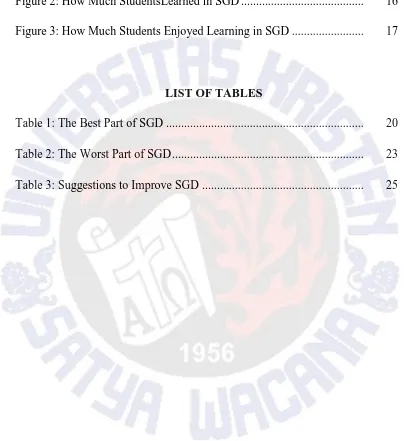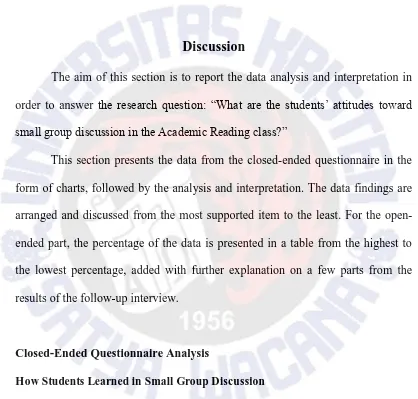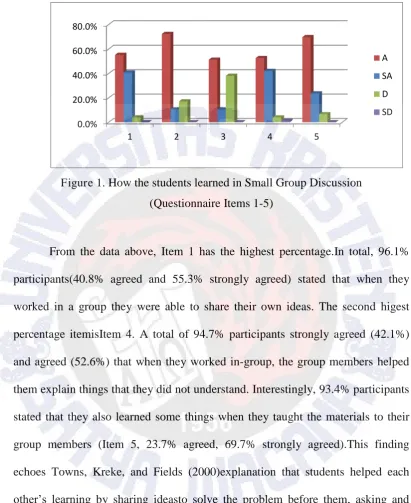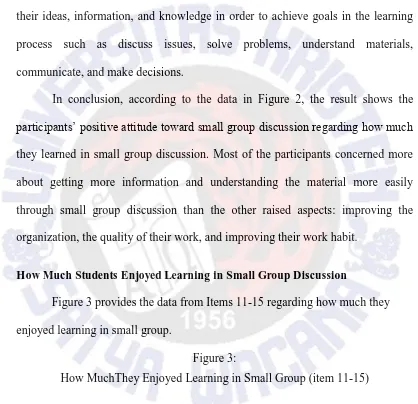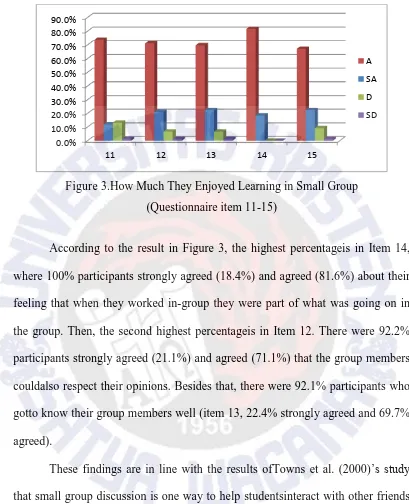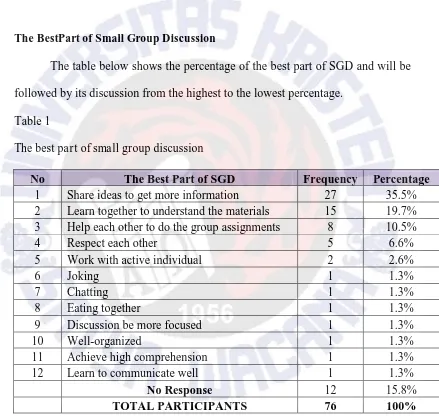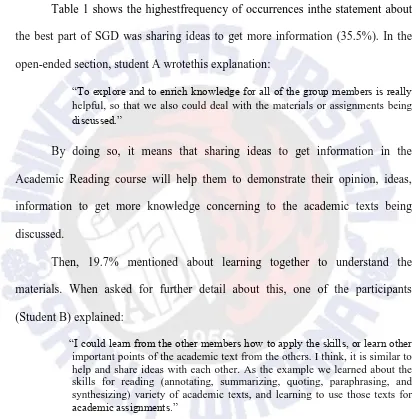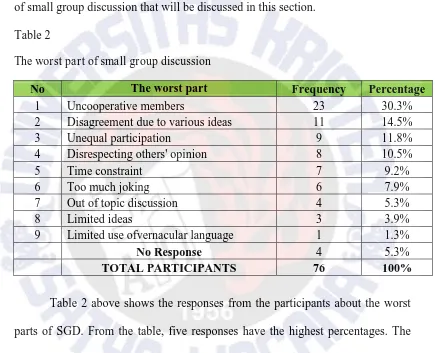STUDENTS’ ATTITUDES TOWARD SMALL GROUP
DISCUSSION IN THE ACADEMIC READING CLASS
THESIS
Submitted in Partial Fulfillment of the Requirements for the Degree of
SarjanaPendidikan
Laura MezbaCahayanaSilaban 112012111
ENGLISH LANGUAGE EDUCATION PROGRAM
FACULTY OF LANGUAGE AND ARTS
UNIVERSITAS KRISTEN SATYA WACANA
SALATIGA
COPYRIGHT STATEMENT
This thesis contains no such material as has been submitted for examination in any course or accepted for the fulfillment of any degree or diploma in any university. To the best of my knowledge and my belief, this contains no material previously published or written by any other person except where due reference is made in the text.
Copyright@2016. Laura MezbaCahayanaSilaban and Gita Hastuti, S.Pd., M.A.
All rights reserved. No part this thesis may be reproduced by any means without the permission of at least one of the copyright owners or the English Department, Faculty of Language and Literature, SatyaWacana Christian University, Salatiga.
TABLE OF CONTENTS
Cover Page ... ... i
Pernyataan Tidak Plagiat... ii
Pernyataan Persetujuan Akses... iii
Approval Page ... iv
Copyright Statement ... v
Publication Agreement Declaration ... vi
Table of Content ... vii
List of Figures ... ix
List of Tables... ix
Abstract ... 1
Introduction ... 1
Literature Review ... 3
Attitude ... 3
Small Group Discussion (SGD) ... 4
Previous Research on SGD ... 7
The Study ... 9
Research Design ... 9
Context of the Study ... 9
Participants ... 11
Data Collection Procedure ... 12
Data Analysis Procedure ... 13
Discussion ... 14
Closed-Ended Questionnaire Analysis ... 14
Open-Ended Questionnaire Analysis ... 19
Conclusion ... 29
Acknowledgement... 32
References ... 33
LIST OF FIGURES
Figure 1: How Students Learned in SGD ... 14
Figure 2: How Much StudentsLearned in SGD ... 16
Figure 3: How Much Students Enjoyed Learning in SGD ... 17
LIST OF TABLES
Table 1: The Best Part of SGD ... 20
Table 2: The Worst Part of SGD ... 23
STUDENTS’ ATTITUDES TOWARD SMALL GROUP
DISCUSSION IN THE ACADEMIC READING CLASS
Laura MezbaCahayanaSilaban
Abstract
Small group discussion (SGD) is a way to implement cooperative learning, which is more student-centered than teacher-centered, where students interact and cooperate with each other to achieve individual and group goals. Some research Languages and Arts at Universitas Kristen SatyaWacana (UKSW), Salatiga. The method of this research study was quantitative descriptive by using Likert-scale and open-ended questionnaire. The result of this studyfound that 76 participants had positive attitude toward SGD. Their positive attitude regardinghow they learned, how much they learned, and how much they enjoyed learning in the small group.Therefore, small group discussion was suitable to be implemented in this course to enhance the learning process. What needs to keep in mind is that each group member should be willing to do his/her responsibilities in order to achieve the group’s goal.
Keywords: attitude, cooperative learning, and small group discussion
Introduction
to their life situations. In other words, the teachers dominate the activities in the classroom and the teaching process is merelypassing the knowledge from the teacher to the students. The students are passive recipients who take in whatever taught by the teacher.In this case, it makes the studentshave no strategy to help their own learning processmeaningful, whereas students whoaretaught with a strategy are more highly motivated than those whoare not and can be lead to a more effective learning (Nunan, 1999). As a factor to determine students’ successful learning,teaching-learning strategy itself has a broad meaning and variety.
In education, the term “group discussion” is often used as a strategy in a teaching and learning process. Especially in language learning, “small group
discussion is widely used in the class-room”(Phillips, 1966, p.1).Small group discussion, also called group work, is a way of implementing cooperative learning. As cited in Mo Xue (2013, p.3), many researchers have claimed that “group work is beneficial to L2 learners by offering many and diverse
opportunities of interacting directly with the target language”.
Since group discussion method was a concern for the researchers, it needs to be studied further to enrich information addressing this issue in different contexts. Through this question: “What are the students’attitudes toward small group discussion in the Academic Reading class?” this study wasaimed to assess the students’ attitude toward small group discussion, especially in their Academic
The significance of this study is giving contribution to help the teachers and the students get more information and understanding about the students’attitudes toward small group discussion in their English learning process.
The information from this study will help teachers and students make small group learning more productive and enjoyable so as to aid the success of the teaching and learning process.
Literature Review
In order to discuss students’ attitude toward small group discussion (SGD)
that is commonlyused as a learning strategy in learning English; this literature review provides the theoretical framework and relevant studies for the current study in the topic area of SGD. This section will mainly discuss attitude, small group discussion,andprevious studies on small group discussion.
Attitude
Attitude is people’s mindset or tendency to act in a particular way due to both an individual’s experience and temperament (Pickens, 2005). He also stated
that attitudes include feelings, thoughts, and actions. Attitudes might simply be an evaluation of a person or object, as in “she has a positive attitude toward group work”, or other emotional reactions to people and to objects (e.g., “I dislike bossy people” or “Small group discussion is wasting time”. Hence, attitudes can help us
Moreover, some definitions of attitudehave also been proposed by some other experts. For example, Jowell (2005) believed that attitude is a complex combination of things we tend to call personality, beliefs, values, behaviors, and motivations. He defined an attitudeas “a psychological tendency to view a particular object or behavior with a degree of favour or disfavour” (p.1).Therefore, knowing the students’ attitudes toward small group discussion is an important component of the educational process (Kouros&Abrami, 2006). There are two reasons why it is important. First, students’ attitudes are going to
reflect the quality of a students’ learning experience. Second, it is also to
influence their learning behavior, whether these attitudes enhance or hinder their learning process (p.5).
Small Group Discussion
Small group discussion refers to the situation where a particular number of peoplemeet face to face and through free oral interaction, share, and discuss ideas to arrive at a decision or solution to a problem. Ideally, groups should have between two and five members, to allow everyone to contribute (Davidson, n.d. cited in Shrawder, 2009).
opinion or others’and will later build their self-confidence and sense of belonging. Socially, group discussion will build a sense of working with other people, where all differences are allowed to create good atmosphere in the group.In a similar sense, Oakeshoot (1962, cited in Juan, 2014) mentioned thatgroup discussion or group work might help increase the participants’ motivation to do their responsibility in learning.
According toPhillips (1966), “small-group methods have been extensively used in a number of educational contexts.” (p.52).People use language in small group discussion in order to discussissues, solve problems, understand materials, communicate, and make decisions. In small group discussion, each group member could elaborate their ideas, information, and knowledge to achieve goals in the learning process. Phillipsalso added that small group discussion is widely used by teachers in classroom activities. Indirectly, students become more familiar with the method and thus begin to use small group discussion as their learning strategy, even outside the classroom activity, to make their learning process become easier, more fun, more enjoyable, and moreeffective (p.20).
By learning from the above definitions and the detailed explanations about small group discussion,it can be said that small group discussion is a way to implement cooperative learning.Cooperative learning has been defined as “student-centered, instructor-facilitated instructional strategy in which a small
group of students is responsible for its own learning and the learning of all group members” (Li & Lam, 2005, p.1). In other words, in cooperative learning, the
elements of a subject matter in order to solve problems and complete a task or achieve a goal.
Furthermore, Johnson and Johnson (2001, cited in Felder & Brent, 2007) proposed five elements of cooperative learning. The first element is positive interdependence, in which the team members are obliged to rely on one another to achieve the goal. If any team members fail to do their part, everyone suffers consequences. The second element is individual accountability, which requires each member of the group to share their own work and master the materials to be learned. Third, face-to-face interaction, demands all members in the group to be interactive to give feedback, reasons, solutions, and conclusion in the discussion. The fourth element, appropriate use of collaborative skills, encourages and helps group members to develop and practice trust-building, leadership, decision-making, communication, and conflict management skills. Finally, in the fifth element, group processing, team members set group goals and assess what they are doing well as a team.
Moreover, seen from its practice where the intellectual, emotional, and social aspects of the learners are encouraged (Brewer, 2013), SGD can be regarded as a means to implement Oxford’s learning strategies (1990, cited in Lee, 2010), which include cognitive, emotional, and social aspects, among others, to enhance learners’ language learning proficiency and self-confidence.
strategies” (p.17). The first three categories are the direct strategies, and the other
three are the indirect ones.
Previous Research on Small Group Discussion
A study was conducted by Towns, Kreke, and Fields (2000) about students’perspectives of small group learning in Chemistry.That study aimedto
discover how the activities could be improved, and to learn how the students' perception of small group learning changed. The participants were undergraduate students at a large Midwestern university in the United States. Through an analysis of field notes and a student questionnaire, two findings emerged which described the students’ perceptions of small group learning activities in an undergraduatechemistry course.The small group learning was beneficial for the students. The firstfindingwassmall group learning activities provided a mechanism for students to develop a feeling of community in the classroom: through interacting, they could rely on and trust each otherso that a feeling of community grew. Second, relationships were viewed as a positive force in learning, which promoted achievement through commitment and mutual goals. Students facilitated each other's learning by teaching each other, sharing approaches to problem-solving and asking questions.
intimate contact with academic staff than more formal methods permit. It also develops the more instrumental skills of listening, presenting ideas, and persuading (p.5).
Another study was conducted by Li and Campbell in 2005 in a New Zealand tertiary institution with22 Asian students as the participants. The aim wasto examine their perceptions toward the much-promulgated collaborative learning in the form of group work and group assignments.Through individual semi-structured interviews, they found that Asian students show positive attitudes towards group discussions where they could interact with students from diverse cultural background, improve their English language skills, and promote their cultural understanding (p.82).
From all of theexplanationsabove,small group discussion is a way to implement cooperative learning, which is more student-centered than teacher-centered. Small group discussion is also a learning strategy that is included in Oxford’s taxonomy of social strategies, where students interact and cooperate
with each other in a small group to achieve individual and group goals. Some research studies have also shown the benefits of small group discussion based on students’ point of view. Therefore, in this current study the researcher would like
to know whether the students’ attitude toward SGD in this context is similar or
The Study
Research Design
The method of this researchis descriptive. It aimsto find out the attitude toward small group discussion of students majoring in the English Language Education Program (ELEP) of the Faculty of Languages and Arts at UniversitasKristen SatyaWacana(UKSW), Salatiga. The study tries to answer the research question:
What are the students’ attitudes toward small group discussion in
the Academic Reading class?
Context of the Study
The objectives by learning the skills in this course were to enable the students to identify and evaluate arguments, to quote, to paraphrase, to annotate academic texts, and to synthesize several articles on similar topics for academic purpose. Moreover, these skills would be useful for studentsin the Academic Writing Course and their final thesis.
The teacher often used small group discussion as a student activity in the classroom. It wasused to discusshow to apply the aforementionedskills in reading the academic texts.Moreover, there were also assignments, and presentationsthat should be done in groups.The assignments were related to the implementation of the skills that had been discussed in class.Additionally, students also needed to evaluate the argument from a particular academic text. Those assignments aimed to measure the students’ understanding about the skills that they have learned.In those activities, students could learn both by themselves and from other people as they shared their ideas, additional information, and knowledge about the skills or the texts they read. In other words, this course required the students to work together to understand texts, to do assignments related to the materials given, and to help them apply the skills learned in this course more easily.
Participants
The participants for this study were 76 students from batch 2013 who took the Academic Reading course in Trimester 1, 2015/2016. The basic reason of choosing the students from batch 2013was thataccording to the curriculum used in ELEP, Academic Reading course was opened for batch 2013in Trimester 1, 2015/2016 and the ELEP data recorded that76 studentsfrom batch 2013were registered in the course.In that semester, four classes of Academic Reading were opened andwere taught by different teachers. However, the classes followed the same syllabus and rules.Therefore, the participants represented the whole population at that time. During the data collection, all the participants returned the questionnaire.They have answered all closed-ended items, but some of them had no response in one or two numbers in the open-ended questions.
Data Collection Instrument
attitude statements were included in the closed-ended section of the questionnaire in this study. Because the original questionnaire is too broad, the researcher made it simpler by grouping them into several categories. The15 statements covered the students’ attitude on how they learned(items 1-5) to represent their actions, how
much they learned (items 6-10) to represent their thoughts, and how much they enjoyed learning in small group (items 11-15) to represent their feelings. Actions, thoughts, and feelings are the three aspects of attitude proposed by Pickens(2005).
The participants indicated their responses on fourLikert scale ranging from strongly agree (SA), agree (A), disagree (D), or strongly disagree (SD). They gave atick () in each option of the statement. Here the researcher did not use the “neutral or undecided” option like in the original SAGE questionnaire toavoid the
middle answersand to make the participants’ answers clearer and easier to analyze.
In addition to that, three open-ended questions were added to elicit the participants’opinions about the best and the worst partsof small group discussion, and how to improve the practice ofsmall group discussion. There were also follow up questions given to 6 participants to give further explanation on a specific point of their answers. These 6 participants had filled in the consent form in the questionnaire that made the researcher easier to meet the participants.
Data Collection Procedure
participants (McKay, 2006).In total, there were 76 studentsof batch 2013as the participants of this study.Hence, for the pilot study,the questionnaire was distributed to 19 students from batch 2012 as the participants, considering that students of this batch had previously taken the Academic Reading course.The second step was revising the questionnaire itemsthat were regarded to be confusing for the participantsbased on the pilot study result. The 15 items of closed-ended were put in numbers randomly. After the piloting was done, the questionnaire were rearranged and revised. Each item in the closed-ended were categorized into three regarding how they learned, how much they learned, or how much they enjoyed learning in small group discussion.
The last step, the final questionnaire was distributed in 2016 (2ndTrimester / 2015-2016)to the76 participants from Batch 2013 that had passed
the course.The follow up questions were given to the 6 participants one day after they filled in the questionnaire.
Data Analysis Procedure
were three parts concerning the best part, the worst part, and the ways to improve the practice of small group discussion. For each question above, the participants’ responses were coded into several categories, and the frequency of occurrence was counted. The data were then summarized into tables.
Discussion
The aim of this section is to report the data analysis and interpretation in
order to answer the research question: “What are the students’ attitudes toward small group discussion in the Academic Reading class?”
This section presents the data from the closed-ended questionnaire in the form of charts, followed by the analysis and interpretation. The data findings are arranged and discussed from the most supported item to the least. For the open-ended part, the percentage of the data is presented in a table from the highest to the lowest percentage, added with further explanation on a few parts from the results of the follow-up interview.
Closed-Ended Questionnaire Analysis
How Students Learned in Small Group Discussion
Figure 1 provides the data from items 1-5. The data is about the students’ attitude regardinghow they learned in small group. This is going to reflect the quality of students’ learning experience and to influence their learning behavior
Figure 1. How the students learned in Small Group Discussion (Questionnaire Items 1-5)
From the data above, Item 1 has the highest percentage.In total, 96.1% participants(40.8% agreed and 55.3% strongly agreed) stated that when they worked in a group they were able to share their own ideas. The second higest percentage itemisItem 4. A total of 94.7% participants strongly agreed (42.1%) and agreed (52.6%) that when they worked in-group, the group members helped them explain things that they did not understand. Interestingly, 93.4% participants stated that they also learned some things when they taught the materials to their group members (Item 5, 23.7% agreed, 69.7% strongly agreed).This finding echoes Towns, Kreke, and Fields (2000)explanation that students helped each other’s learning by sharing ideasto solve the problem before them, asking and
answering questions, and teaching each other.
In conclusion, according to the data in Figure 1, the resultshows thatthe participants have positive attitude toward small group, in that it helps the learning process through sharing ideas and helping each other to understand the material.
How Much Students Learned in Small Group Discussion
Figure2 provides the data from Items 6-10. Interestingly, Figure 2 shows the positive result based on how much they learned in small group.According to Hornby (2009 cited in Al-Yaseen, 2014), cooperative learning or group work is effective in promoting academic achievement of students of all ages. The chart below presents the positive attitude toward how much they learned in small group.
Figure 2. How much students learned in Small Group Discussion (QuestionnaireItems 6-10)
From the data in Figure 2 above, two items receive the highest percentages of positive response. The highest percentageis in item 7; 97.4% participants stronglyagreed (32.9%) and agreed(64.5%) that when they worked in group, they are learning more information. Positively, the second highest percentageis 93.5%.The participants strongly agreed (22.4%) and agreed (71.1%) that when they workedin-group, it could make the materials easier to understand (item 10).These may be related to the findings in the previous discussion about how they learned in small group discussion, i.e. the participants shared their ideas and
helped each other to understand the material. It can be interpreted that by sharing ideas and helping each other to understandthe material, they can learn more information andunderstand the material more easily. As written in a book by Phillips (1966), in small group discussion each group member could elaborate their ideas, information, and knowledge in order to achieve goals in the learning process such as discuss issues, solve problems, understand materials, communicate, and make decisions.
In conclusion, according to the data in Figure 2, the result shows the participants’ positive attitude toward small group discussion regarding how much
they learned in small group discussion. Most of the participants concerned more about getting more information and understanding the material more easily through small group discussion than the other raised aspects: improving the organization, the quality of their work, and improving their work habit.
How Much Students Enjoyed Learning in Small Group Discussion
Figure 3 provides the data from Items 11-15 regarding how much they enjoyed learning in small group.
Figure 3:
Figure 3.How Much They Enjoyed Learning in Small Group (Questionnaire item 11-15)
According to the result in Figure 3, the highest percentageis in Item 14, where 100% participants strongly agreed (18.4%) and agreed (81.6%) about their feeling that when they worked in-group they were part of what was going on in the group. Then, the second highest percentageis in Item 12. There were 92.2% participants strongly agreed (21.1%) and agreed (71.1%) that the group members couldalso respect their opinions. Besides that, there were 92.1% participants who gotto know their group members well (item 13, 22.4% strongly agreed and 69.7% agreed).
In conclusion, according to the data in Figure 3, the result shows the participants’ positive attitude toward small group discussion regarding how much
they enjoyed learning in small group discussion. Here, all of the participants felt that they were part of what was going on in the group and they got to know each other well.In addition, they could respect each other’sopinions
In general, the results of closed-ended questionnaire in Figure 1 up to Figure 3 illustrate the participants’ positive attitudes toward small group discussion, regarding how they learned, how much they learned, and how much they enjoyed learning in small group. Through small group discussion in the Academic Reading class,with regard to how they learned that represented their actions in the small group discussion, the participants were able to share their own ideas and to teach or to help explaining the materials that other members did notunderstand, by doing so, they could learn more.In terms of how much they learned that represent their thoughts, small group discussions helped them learn more information and understand the materials more easily.Moreover, how much they enjoyed learning in small group discussion represent their feelings. Asthe participants could feel as a part of the group,respect each other’s opinions, and know each other well, it can be inferred that they enjoyed the learning process in small group discussions.
Open-Ended Questionnaire Analysis
worst part, and how to improve the practice of small group discussion. The tables in this section will show the frequency and percentage of the participants’ responses to the open-ended questions. It will be discussed from the highest to the lowest percentage.
The BestPart of Small Group Discussion
The table below shows the percentage of the best part of SGD and will be followed by its discussion from the highest to the lowest percentage.
Table 1
The best part of small group discussion
No The Best Part of SGD Frequency Percentage
1 Share ideas to get more information 27 35.5% 2 Learn together to understand the materials 15 19.7% 3 Help each other to do the group assignments 8 10.5%
3 are regarding how they learned in small group. Then, statements 4 up to 5 are regarding how they enjoyed learning in small group. For number 6 up to 12 are the new opinions that are different from the Likert-scale questionnaire items.
Table 1 shows the highestfrequency of occurrences inthe statement about the best part of SGD was sharing ideas to get more information (35.5%). In the open-ended section, student A wrotethis explanation:
“To explore and to enrich knowledge for all of the group members is really
helpful, so that we also could deal with the materials or assignments being
“I could learn from the other members how to apply the skills, or learn other
important points of the academic text from the others. I think, it is similar to help and share ideas with each other. As the example we learned about the skills for reading (annotating, summarizing, quoting, paraphrasing, and synthesizing) variety of academic texts, and learning to use those texts for
academic assignments.”
Similar to the finding in Towns et al. (2000)’s study which emphasized that while working in-group, students facilitated the learning process by teaching, sharing approaches to problem-solving and asking questions to each other.
texts and skills for reading, it means helping each other could make the assignments easier and finish it more quickly because they work together with other members.
The next was 6.6% participants feel more comfortable if each member in the group could respect each other. It might be able to build a positive atmosphere in the learning process in small groups.
Interestingly, there were 2.5% participants who stated that working with active individual is the best part of SGD. One of two participants that gave the statements (Student C) wrote that:
“This active student is similar with one dominant student. Usually the
dominant student is active and smart.”
The WorstPart of Small Group Discussion
The table below shows the percentage of the best worst of SGD and will be followed by discussing them from the highest to the least supporters. There were new opinions based on the participants’ responses regarding the worst part
of small group discussion that will be discussed in this section. Table 2
The worst part of small group discussion
No The worst part Frequency Percentage
1 Uncooperative members 23 30.3%
2 Disagreement due to various ideas 11 14.5%
3 Unequal participation 9 11.8%
4 Disrespecting others' opinion 8 10.5%
5 Time constraint 7 9.2%
6 Too much joking 6 7.9%
7 Out of topic discussion 4 5.3%
8 Limited ideas 3 3.9%
9 Limited use ofvernacular language 1 1.3%
No Response 4 5.3%
TOTAL PARTICIPANTS 76 100%
Table 2 above shows the responses from the participants about the worst parts of SGD. From the table, five responses have the highest percentages. The first highest percentage was 30.3% participants stated that uncooperative group members as the worst part of SGD. In the open-ended section, one of the participants (student D) mentioned that uncooperative group member was someone whowas passive in the discussion andwas lazy to do the task. She argued that:
cooperate. They did not participate actively in the group discussion even
difficult to connect with both the task and other member.”
The second highest percentage was 14.5%, where the participants mentioned about disagreement due to various ideas. Since we know the result of the best part of SGD is about sharing ideas to get more information, it means that this problem might potentially appear in the group discussion. When the students have different ideas, they could agree or disagree with other friends’ ideas and opinions. The participants wrote that it was hard to choose the best decision on whose ideas or opinions would be added and made the group members debate on different ideas. Sometimes it could make misunderstanding with the other members.
The third, 11.8% participants mentioned regarding unequal participation. As the example arethe task divided unequally or unwell-organized task, and one dominant student. When asked for detail about one dominant student, student E explained that:
“One dominant student was the one who is smart and sometimes dominates in
everything that going on in the group.”
Another participant wrote that sometimes only one student who dominates in the group discussion.
The fourth, the participants (10.5%) mentioned about disrespecting others’
members respect each other. Therefore, the percentage of disrespecting others is highest than respecting others.
The fifth, 9.2% mentioned time constraintas the worst part of SGD. As the example areit is hard to find time to work together, the time management during the process of doing the group assignments, and the absence of the group membersin group’s meeting. As Student F wrote that busy schedule of each individual made the group could not find the day or time for the discussion.
Interestingly, the 7.9% participants stated about joking too much with the group members as the worst part of group discussion. However, one participant (1.3%)stated that joking as the best part of small group discussion. In other words, joking was good to make the situation in the discussion more fun, but too much joke was not good either. Therefore, they should know the portion when they joke during the discussion. However, from all the response given, 4 out of 76 participants (5.3%) did not respond to the question.
Suggestions to Improvethe Practice of Small Group Discussion
The participants already gave their responses to the best and the worst parts of small group discussion. In order to make their small group discussion work better, they have to know how to improve the practice of small group discussion. The participants’ suggestions to improve SGD werediverse. There
Table 3
The suggestion to improve the practice of SGD
No Suggestions to improve the practice of SGD Frequency Percentage
1 Initiative to be active 13 17.1% which demandsall the members in the small group discussion create an interactive discussion by giving feedback, solutions, opinions, ideas.
to one of cooperative learning by Johnson and Johnson which is about positive interdependence in which the team members are obliged to do each other part, but everyone has responsible for helping each other parts. The reason is because if one of them fail to do their part, everyone suffers the consequences.
Third, the other 13.2% participants suggested that the group members should work together seriously. One of the worst parts of SGD is too much joking with the group members have mentioned earlier by the participants. However, some of participants also mentioned joking as the best part of SGD. Therefore, they need to work together seriously; butthey could add some jokes to create a good situation during the discussion.
Fourth, 11.8% participants suggested that the group members should respect each other. The participants already mentioned it earlier; one of the best parts of small group discussion is about respecting each other. The supporting reason according to that statement is because healthy relationships with other classmates allow for personal growth and responsibility (Zhang, 2010 in Al-yaseen, 2014).
exist difficulties or misunderstandings among group members, etc (Johnson & Johnson, 2007 in Zhang 2015, p.20).
Interestingly, there were also participants (6.6%) who suggested that the students should choose the group members by themselves. Another explanation by Student C:
“Personally, I like to choose the group member by myself because
sometimes we are more comfortable working with friends that we have
already known.”
On the other hand, student A argued that:
“I think the lecturer need to know the students’ profile (background
knowledge). So, the lecture able to divide students in appropriate way. The meaning of appropriate itself is the groups not consist of all students who are active or smart, but the combination between passive and active students. This kind of combination to motivate and increase the knowledge of the
passive student.”
In a line with the opinion given by student A, Cooper (n.d., Cited in Shrawder, 2009) stated that for the occasional informal small group, avoid allowing students to form their own groups. When groups are self-selected, students are more likely to stray from the objective and form cliques (p.7).
their group. However, there were also 13.2% participants who did not answer regarding to this question.
Learning from all the responses and the explanations above there were several suggestions to improve the practice of small group discussion. According to the participants’ responses the suggestion to make the group work better, it
could be coming from the individual’s self-awareness and from the cooperation in the group itself, for examplehaving initiative to be active, being open-minded, and respecting and understanding the task well.Concerning to the cooperation in the group itself for exampledividing the task equally, working together seriously, and building a good communication.
CONCLUSION
Since the term of “group discussion” is often used in a teaching and
learning process, especially in language learning, the aims of this study was to assess the students’ attitude toward small group discussion in the Academic
Reading Class by discovering how they think, feel, and behave when working with other students in that course. The participants were majoring in English Language Education of the Faculty of Language and Artsat Universitas Kristen SatyaWacana, Salatiga in the 2015/2016 academic year.
helping to explain the things that the other members do not understand. Therefore, by doing so, most of the participants also learn something when they could teach the materials to the other members. In terms of thoughts, the participants learned more information from sharing the ideas and help each other to explain the things they do not understand. It could make the materials easier to understand. In terms of feelings, on how much they enjoyed learning in small group discussion help the students feel they were part of what is going on in the group, help them get to know their group well and learn how to respect each other’s opinion.
With regard to the open-ended questionnaire, the two best parts of small group discussion involve sharing ideas to get more information, and learning together with the group to understand the materials. As the worst parts, the two highest percentages were about working with uncooperative members and disagreement due to various ideas from the group members. Therefore, the participants suggested that each group members should have initiative to be active in the discussion and the group’s work. However, they also suggested that the task
for each member should be divided equally, but it still becomes the group’s responsibility. Then, each member needs to work seriously and does not joke too much.
Based on the findings on this study, small group discussion was suitable to be implemented in this course. Teacher could use small group discussion to enhance the students’ learning quality by learning with other students in order to
ideas from each other, so that they also could get more information about the text itself. Each member in the group could demonstrate their opinion, ideas, information to get more knowledge of the texts. It makes the works easier to be done.However, to ensure that the SGD enhances the learning process, each group member should be committed to their responsibilities in order to achieve the group’s goal.
This research study has reached its aim, but it still has the limitation. This study may represent other students’ attitude toward SGD, but it cannot be generalized to the other study programs. The reason is that the other studies have different context, background, and participants. The course could also affect the way the students learn on different materials. Therefore, the result might be different. Another limitation, this research study has small range. It focuses onlyon one small course. Therefore, further study is needed to investigate broader aspects concerning other elements such as the gender, teacher’s preference for their teaching method, campus environments, etc, in order to find outwhether those elements could affect the students’ attitude toward small group discussion or
ACKNOWLEDGEMENT
First of all, my greatest gratitude is dedicated to my Lord, Jesus Christ who gives me strength in every condition and situation, because without his blessing I would not be able to finish my thesis. The second, I am so thankful to my supervisor Gita Hastuti,S.Pd.,M.A.,for always being patient and willing tospend her time and energy to guide me during the process of making this thesis. As for the examiner, VicaAnantaKusuma, S.Pd.,M.A., I really thank with a grateful heart for her willingness to read,give feedback, andexamine my thesis.
I also want to express my thankfulness to my family (my father, my mother, my grand mom, and my two brothers) whoalways pray and support me. Moreover, I will not forget to thank my sisters in Salatiga (HestiDatemoli, Vita Sisilia, MeyGomies,WindiIsmitasari and BernikeFourina) who were always there to be the best listeners and supporters.Then, I also thank to all my friends that I may not be able to mention one by one.
REFERENCE teaching. Glasgow, University of Glasgow Learning and Teaching Centre.
RetrievedSeptember 21, 2015,
fromhttp://www.gla.ac.uk/media/media_12157en.pdf
Juan, L. (2014). Study on Group Discussion-Based English Reading Teaching.Higher Education of Social Science.7(1), 102-106. Retrieved
September 21, 2015,
fromhttp://www.cscanada.net/index.php/hess/article/viewFile/5231/pdf73
Jowell, R. (2005). Understanding and Measuring Attitudes. Scottish Government Social Research Group Social Science Methods Series.Retrieved February 6, 2016,fromhttp://www.gov.scot/resource/doc/175356/0091396.pdf
Kouros, C., Abrami, P. C., Glashan, A., & Wade, A. (2006). How do students really feel about working in small groups? The role of student attitudes and behaviors in cooperative classroom settings.In annual meeting of the American Educational Research Association, San Francisco,
California.RetrievedMay 31, 2016, group assignments in a New Zealand tertiary institution. Intercultural Education,19(3), 203-216. Retrieved June 3, 2016,
fromhttp://www.tandfonline.com/doi/abs/10.1080/14675980802078525
McKay, S.L. (2006). Researching second language classrooms. Mahwah, NJ: Lawrence Erlbaum Associates, Inc.
Oxford, R. L. (2003). Language Learning Styles and Strategies: An Overview.
Retrieved October 9, 2015,
fromhttp://web.ntpu.edu.tw/~language/workshop/read2.pdf
Pickens, J. (2005). Attitudes and perceptions. Organizational Behavior in Health Care. Sudbury, MA: Jones and Bartlett Publishers, 43-75. Retrieved
December 6, 2015,
from http://healthadmin.jbpub.com/borkowski/chapter3.pdf
Phillips, G. M. (1966). Communication and the Small Group. New York: The Bobbs-Merrill
Shrawder, J. H. (2009). How to Make Small Group Learning Work.Teaching for Success.Retrieved September 21, 2015,
from
https://www.marin.edu/WORD-PPT/TFS_HowToMakeSmallGroupLearningWork.pdf
Towns, M. H.; Kreke, K.; Fields, A. (2000).An Action Research Project: Student Perspectives on Small-Group Learning in Chemistry. J. Chem. Ed. 2000,
77, 111–115.
Appendix
QUESTIONNAIRE
Dear friends,
I am Laura MezbahCahayanaSilaban from batch year 2012, in order to complete my thesis and to find out your attitudes on small group discussion; I need your help to fill in this questionnaire. There are two parts you need to fill in. This questionnaire is going to answer the research question: “What are the students’ attitudes toward small group discussion in the Academic Reading Class?” Your responses to the questionnaire will be kept confidential. Please answer honestly, as this will not affect your grade in any way.
Demographic Information
Statements about Students’ Attitude toward Small Group Discussion in Academic Reading Course
SA A D SD
1. When I work in a group, I am able to share my ideas
2. When I work with other students the work is divided equally 3. One student usually makes the decisions in the group
4. My group members help explain things that I don’t understand
5. I also learn when I teach the material to my group members 6. When I work in group, I do better quality work
Part II
Please kindly answer these questions as clearly as possible.
1. In your opinion, what is the best part of small group discussion?
2. In your opinion, what is the worst part of small group discussion?
3. How to improve the practice of small group discussion? 8. When I work in group, my work habits improve
9. When I work in group, my work is better organized
10. When I work in group, the material is easier to understand 11. I enjoy the materials more, when I work with other students 12. My group members respect my opinions
13. I get to know my group member well
14. I feel I am part of what is going on in the group
Consent form
If I need more information on your questionnaire, can I contact you for an interview?
Yes / No (Please circle one)
If you say yes, complete the following information. Name +No. HP :
Email :
